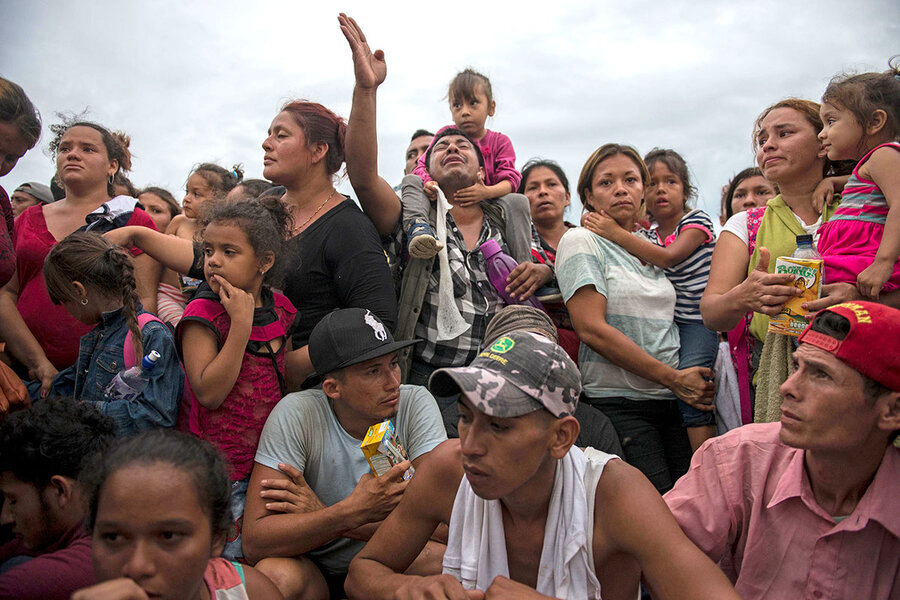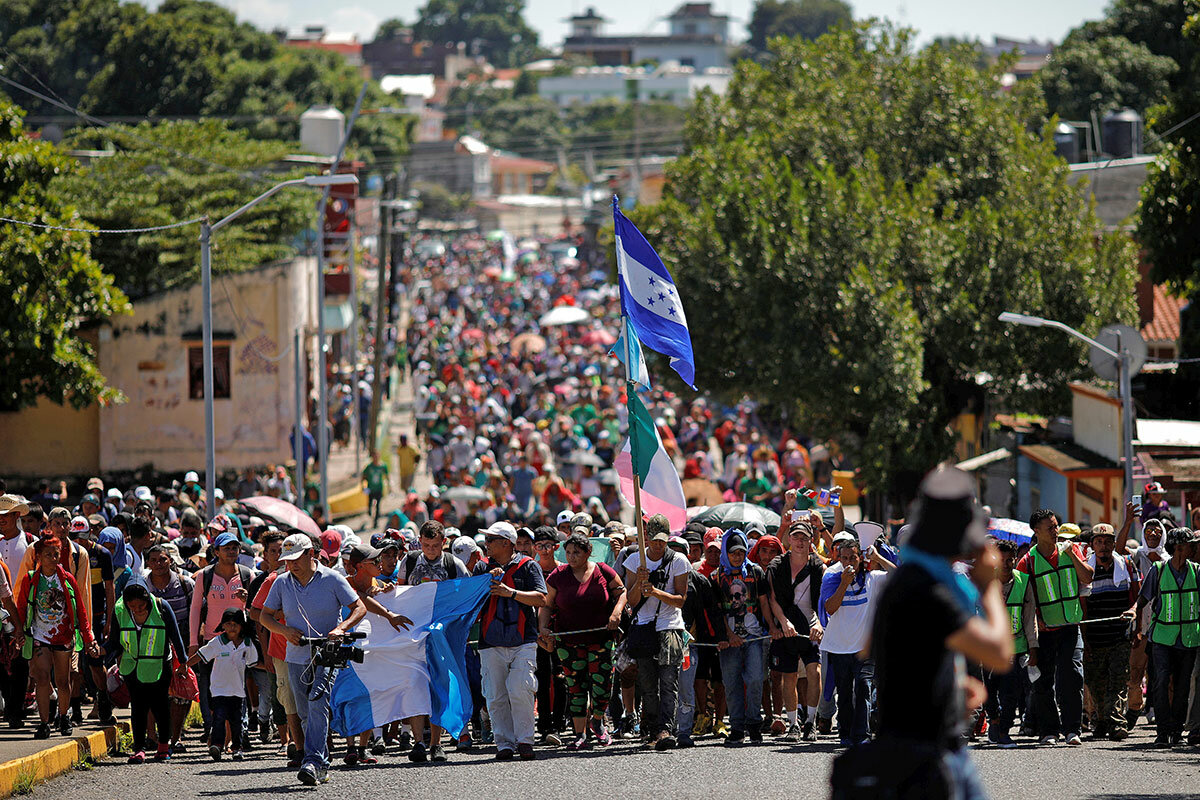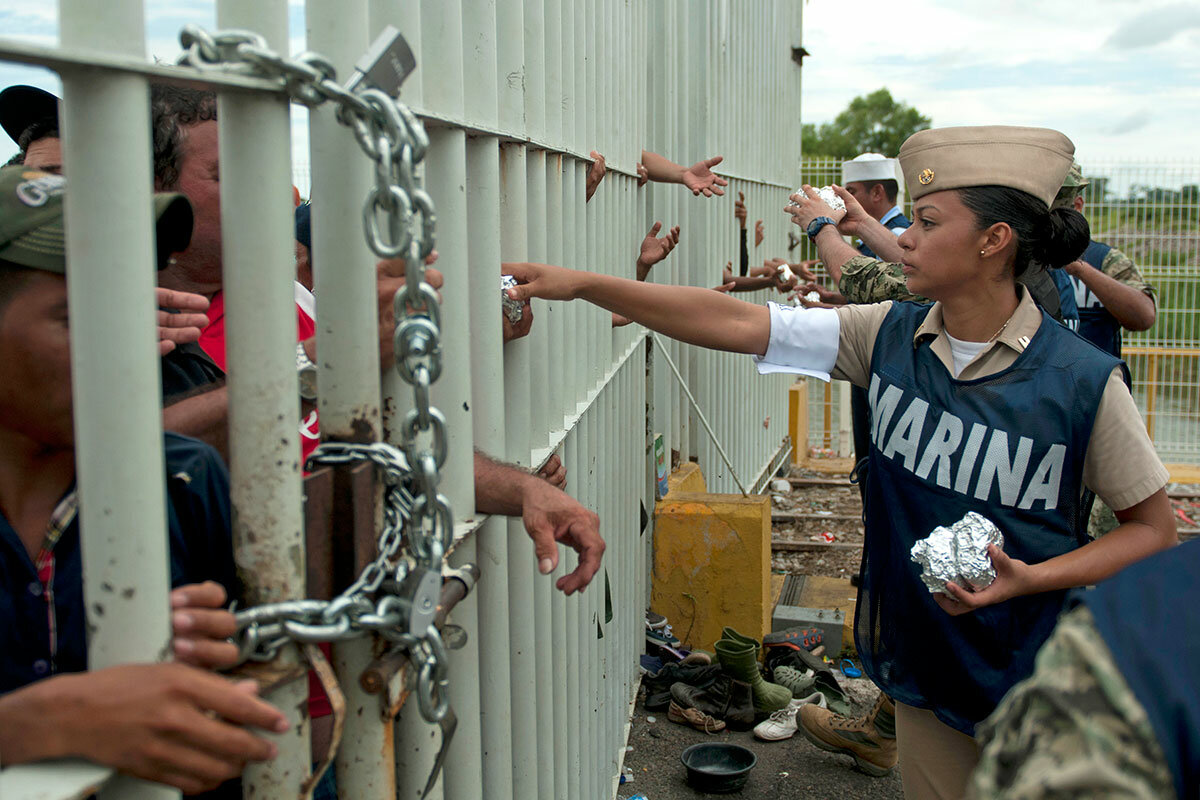As caravan wends its way north, Mexico walks a fine line
Loading...
| Tecún Umán, Guatemala; Mexico City and Tapachula, Mexico
“Sí se pudo! Sí se pudo!” some 4,000 Hondurans chanted last Friday, as they crossed the bridge above the Suchiate River dividing Guatemala and Mexico. We did it!
The jubilation was short-lived, as the migrants and refugees were stopped after a week-long journey by a row of Mexican riot police. As the crowd pressed forward on the bridge, tearing down barriers that blocked entrance into Mexico, the police responded with tear gas. For a moment, amid the pressing bodies and swaying bridge, a stampede seemed inevitable.
By Tuesday, Mexico was processing 2,727 asylum requests related to the caravan, officials said. The government says it will let in groups of 150-200 asylum-seekers per day. Another several thousand, frustrated and sometimes scared by the long wait, took their chances by swimming, or hiring rafts, to get across. Those entering illegally will be deported, officials have warned, but by the end of the weekend, caravan members who had already crossed into Mexico voted to continue moving north regardless.
Why We Wrote This
Amid the American debate over the migrant caravan, Mexico’s own struggles to deal with the situation are often overlooked. But they are substantial and point to a country trying to balance different needs.
The caravan, which has since grown to an estimated 7,000 people from across Central America and Mexico, left San Pedro Sula, Honduras, on Oct. 12. Like the many, much smaller caravans before it, its aim was to create safety in numbers as migrants crossed Guatemala and Mexico toward the US southern border.
In a series of tweets this week, US President Trump called the caravan a national emergency and reiterated criticisms of El Salvador, Honduras, Guatemala, and Mexico for not halting the flow at their borders. He’s threatened to pull US funding for countries that allow migrants and asylum-seekers north.
Mexico appeared to take heed, deploying some 400 federal police to its border late last week and putting out statements about who can qualify for asylum in Mexico. They also broadcast the repercussions for crossing the border illegally, and called on the United Nations’ Refugee Agency for help with the influx.
Mexico’s preemptive moves are unprecedented, observers say – like the immense size of the caravan itself. Although Mexico has appeared eager to appease the United States, cracking down on lax migration on its border with Guatemala since 2014, it’s also on the cusp of a potentially new immigration policy under incoming President Andrés Manuel López Obrador, who campaigned on promises not to kowtow to the US. The new administration has signaled willingness to issue temporary work visas to Central American migrants, and Mr. López Obrador said in a speech in the southern state of Chiapas this week that he wants people in the caravan to know “they can count on us.”
“Mexico is in a difficult situation,” says Néstor Rodríguez, an immigration expert at the University of Texas at Austin. “They don’t have the strongest posture until the new president comes on board [and] they are pressured by the migrants as well as the US.”
'A better place where there's no crime'
Images of the caravan – stretching more than a mile on rural roads in Guatemala; filling the vast border-crossing bridge leading into Mexico; and its crowds huddled in plazas, trying to decide how to proceed – are reminders of the widespread violence, economic instability, poverty, and government repression many Central Americans are trying to escape.
Heidy Marleny Castro waited on the bridge over the weekend, weighing her options: stay in line without food or water, possibly for days, until she can speak to a Mexican official; or cross the river without registering, in order to continue. She’s traveling with her two youngest children, 8 and 13 years old. Her two oldest sons were killed by gangs in Honduras in 2015.
“We live in a scary country,” she says, raising her voice above the din of the crowd, and keeping a watchful eye on her kids amid the chaos. “We’re making this sacrifice for our children because we want a better life for them.”
With 3,791 murders in 2017, Honduras has a per capita homicide rate of 42.8 violent deaths per 100,000 inhabitants, making it one of the most violent countries in the world.
Malena Soto, a young mother, says she joined the caravan because she can’t afford to feed her two children on the $6 per day she earns selling food on the street in Honduras. According to the World Bank, nearly 61 percent of Hondurans live below the poverty line.
Several unaccompanied minors joined the caravan without their parents’ permission. Among them is Jonathan Losán Cruz. At the age of 14, he’s been mugged twice at gunpoint, and fears gang recruitment in his crime-ridden neighborhood in coastal Honduras. He wants to travel all the way through to the US, a country he imagines as “a better place where there’s no crime.”
'Unprecedented' challenge
Over the past two decades, many caravans have begun the trek north, with people assuming it’s safer than traveling on their own across Mexico: a journey that carries great risk of extortion, violence, kidnapping, and abuse by officials or organized criminals. It is also a chance to save money, as human smugglers can charge a migrant more than $5,000.
“In practice, this number of people is hard for any government to manage,” says Maureen Meyer, the director for Mexico and migrant rights at the Washington Office on Latin America, a research and advocacy organization. She calls the size of this caravan “unprecedented.”
Previous caravans have often shrunk dramatically as they progress – routes across Mexico toward the US border can cover more than 2,000 miles – with people deciding to turn back or stay put along the way. Last spring, for example, one group that had reached 1,500 migrants dwindled dramatically: 401 requested asylum in the US, and another 122 were apprehended trying to enter illegally. (Of the current caravan’s travelers, more than 1,000 Hondurans are estimated to have already returned home.)
Mexico has increased enforcement on its southern border in recent years, “not just in response to the US, but for clearer control of people and goods,” Ms. Meyer says. Mexico’s preliminary response of communicating with the caravan, trying to process the group in an orderly fashion, and calling for reinforcements from the United Nations was positive, she said. But reports of police violence on Friday need to be investigated, she adds.
In southern Mexico, police have shadowed the caravan, but have not blocked its movement. But there are outstanding concerns. “How do you really monitor and control that many people traveling together?” Meyer asks, noting the possibility for traffickers or other threatening individuals to infiltrate the group. It’s something “Mexican authorities need to be on the watch for now.”
AMLO's first test?
Expectations are high for Mexico’s new president, often referred to by his initials, AMLO. Yet there are few clues as to what changes he can or will implement in practice.
AMLO, who will be inaugurated in December, may have “good intentions” on changing Mexico’s approach to migration, says Sister Magdalena Silva, who runs a migrant shelter in Mexico City. But “there isn’t much margin for change.”
“If AMLO says something and Trump doesn’t like it, he can just threaten Mexico with NAFTA or other resources,” she says in her crowded office, fielding calls and taking messages about the approaching caravan.
The president-elect has criticized migrants’ abuse, and has called for a “zero-tolerance” policy toward abuse by federal and local agents, citizens, and organized criminals, Meyers says.
Although Mexico has deported more Central Americans than the US since 2015, it has also seen a sharp uptick in the number of asylum applications it has received – and approved – in recent years. The fact that it has been able to absorb a few thousand refugees each year in recent years gives some observers hope for a change in migratory flows.
“Anything Mexico can do will be very helpful not just to keep the migrants out of the US, but for the migrants’ sake themselves,” says Professor Rodríguez.







